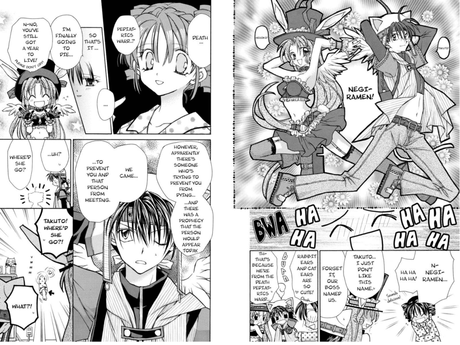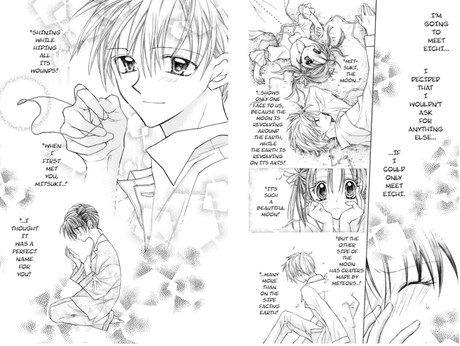Magical girls have been a part of shoujo since nearly the beginning; stories of idols and other performers are almost just as old. Magical girls haven’t changed much over the years, but today’s idol shows like Love Live! are rather different when compared to works like Creamy Mami. Mitsuki of Full Moon o Sagashite (Searching for the Full Moon) has more in common with those earlier idols than she does with AKB0048 or such, but calling her a magical girl isn’t precisely right, either.
While there are plenty of tragic back stories in shoujo from any year (see Kitchen Princess, Fruits Basket, Cain Saga, and Natsume Yuujinchou for varying examples), Mitsuki’s circumstances have a melodramatic quality to them that I associate with an era older than the 2002 to 2004 run it had. As an orphan living with a strict grandmother, Mitsuki has throat cancer. Her grandmother desperately wants her to have surgery so that she doesn’t lose yet another family member, but Mitsuki wants to be a musician like her parents. If she loses her singing voice, a very real possibility with the surgery, then she doesn’t see a reason to keep living anyway. She’s rather close to death already, but a pair of shinigami come to visit her one day. Thinking that it might make sway Mitsuki to come along with them, one shinigami named Takuto offers to use his magic to age her so she can compete in a singing competition, though Mitsuki’s companion Meroko disagrees. What everyone wasn’t expecting was for Mitsuki to have such a lovely voice and get signed on as an idol! Now the two shinigami are sticking close to her as Mitsuki hides her new pop-star life, as people from both her real life and the underworld start poking around to see just what is going on.

So far, Muse and I haven’t expressed strong opinions about whether you should watch the anime or read the manga versions of the various SYSK series (well, don’t watch the ending of the Fruits Basket anime actually, there were shenanigans in that production), but I must strongly recommend the manga over the anime here. Usually I feel the opposite about a music series since having a chance to experience the songs really helps the story; however, the few pop songs the series produces aren’t enough to tip the scales here. The manga is a respectable seven volumes (which clips along at a shockingly quick pace) to the anime’s fifty-two episodes. The anime was also adapted while the manga was still ongoing, so it drags along with oodles of superfluous, filler episodes. Unfortunately, despite the stalling the anime never really “meets up” with the manga again; unlike a series like Naruto that continues right along with the manga, in Full Moon we miss some things. There’s a particularly tragic twist half-way through the manga that occurs much later in the anime, but the nature of it is so completely different that it winds up feeling simply tragic, not heart-wrenching with some disturbing undertones. The anime also cuts out the backstory for all of the shinigami except Takuto (whose was altered if I’m remembering correctly) and even some set-up for how the underworld works — a second plot line is completely removed! Plus, Arina Tanemura’s art simply doesn’t translate as well when animated, so honestly the show looks bland.

Admittedly, Tanemura’s art style has not changed much over the years; the girls have skull-crushingly huge eyes, tiny pointed chins, and even slimmer figures, but if you only read one or two works of hers then it’s much less of a bother. Structurally everything flows well, the screen tones are well-used, and it’s easy to see why Viz even released an art book of her work, mostly of Full Moon. Tanemura seems very comfortable with her style here and the ultra-sugary sweetness of the art also makes sense when you realize that this ran in the magazine Ribbon — a very “shoujo” magazine. My largest quibble with the series is how the many, complicated romantic relationships are handled; I simply thought there were too many and that some of the characters were too contradictory about who they said they loved versus how they acted (within the same time frame, not spread out over the whole series). Ignoring that, it was hard not to get suckered back into rereading the entire series; I consider it a good thing when I still love a story that I first read eight or ten years ago without feeling guilty about it. It’s a cute and earnest series that sings its heart out, even as it becomes less about Mitsuki’s career and more about the people she’s met because of her music.
Missed it? Catch the manga from Viz (available both digitally and in print). The anime was only released in part, also by Viz, before going out of print.

